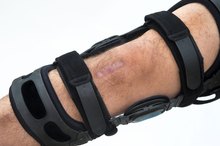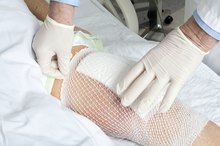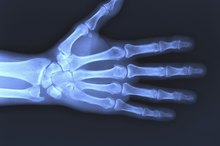Most Common Side Effects After Hip Replacement Surgery
Hip replacement surgery is most frequently used to alleviate painful symptoms experienced by patients with osteoarthritis, a condition in which the hip bone progressively degrades, Cedars-Sinai reports. During this procedure, a surgeon removes damaged bone within the hip and replaces it with prosthetic components made of metal, plastic or ceramic. Before having this procedure performed, patients should be aware of the most common side effects that arise after hip replacement surgery.
Pain
Patients commonly experience sensations of pain within the hip joint after hip replacement surgery, the American Academy of Orthopaedic Surgeons, or AAOS, explains. Hip discomfort can interfere with a patient's ability to stand or walk normally during the first few days following surgery. A doctor typically prescribes pain medication that affected patients can use to control or manage hip pain symptoms. Generally, hip pain progressively subsides as a patient begins to heal from hip replacement surgery. Prolonged, increased or severe pain can be a sign of infection and affected patients should seek prompt care from a medical professional.
- Patients commonly experience sensations of pain within the hip joint after hip replacement surgery, the American Academy of Orthopaedic Surgeons, or AAOS, explains.
- Prolonged, increased or severe pain can be a sign of infection and affected patients should seek prompt care from a medical professional.
Hip Joint Loosening or Dislocation
Complications After Partial Knee Replacement
Learn More
Loosening of the hip joint and hip dislocation are common side effects experienced by patients after hip replacement surgery, according to the National Institute of Arthritis and Musculoskeletal and Skin Diseases. The hip bone prosthetic inserted into the hip joint during surgery is typically smaller than a patient's natural hip bone. This size difference makes it easier for the prosthetic hip ball to slip out of the hip socket. The newly placed hip joint may also inflame or irritate surrounding tissues, which can degrade the remaining healthy hip bone tissue. Bone degradation can cause the hip joint to loosen, increasing a patient's risk of experiencing a hip dislocation. Hip dislocation or joint loosening can be painful and may require additional surgery to replace the prosthetic hip joint into its proper location.
- Loosening of the hip joint and hip dislocation are common side effects experienced by patients after hip replacement surgery, according to the National Institute of Arthritis and Musculoskeletal and Skin Diseases.
- Hip dislocation or joint loosening can be painful and may require additional surgery to replace the prosthetic hip joint into its proper location.
Blood Clots
Blood clots within the legs, a condition called deep vein thrombosis, are a common side effect of this type of hip surgery, AAOS reports. Affected patients can develop unusual leg pain that is accompanied by swelling or skin discoloration. These blood clot symptoms arise due to poor blood flow through the leg. If a blood clot detaches from the inside of a blood vessel in the leg, it can flow through the bloodstream into a patient's lungs. This life-threatening side effect after hip replacement surgery can cause severe breathing difficulties and requires immediate medical attention.
- Blood clots within the legs, a condition called deep vein thrombosis, are a common side effect of this type of hip surgery, AAOS reports.
- This life-threatening side effect after hip replacement surgery can cause severe breathing difficulties and requires immediate medical attention.
Related Articles
References
- Cedars-Sinai: Hip Replacement Surgery
- National Institute of Arthritis and Musculoskeletal and Skin Diseases: Questions and Answers About Hip Replacement
- MedlinePlus: Hip Replacement
- MayoClinic.com: Hip Replacement - Risks
- American Academy of Orthopaedic Surgeons: Total Hip Replacement
- "Management of Infection at the Site of a Total Knee Arthroplasty" J. Bone Joint Surg. Am., Oct 2005; 87: 2335 - 2348.
- CJ Della Valle, DJ Steiger, and PE Di Cesare "Thromboembolism After Hip and Knee Arthroplasty: Diagnosis and Treatment" J. Am. Acad. Ortho. Surg., Nov 1998; 6: 327 - 336.
- Naudie DD, et al. "Wear and Osteolysis Around Total Knee Arthroplasty J. Am. Acad. Ortho. Surg., January 2007; 15: 53 - 64.
Writer Bio
Rae Uddin has worked as a freelance writer and editor since 2004. She specializes in scientific journalism and medical and technical writing. Her work has appeared in various online publications. Uddin earned her Master of Science in integrated biomedical sciences with an emphasis in molecular and cellular biochemistry from the University of Kentucky College of Medicine.









